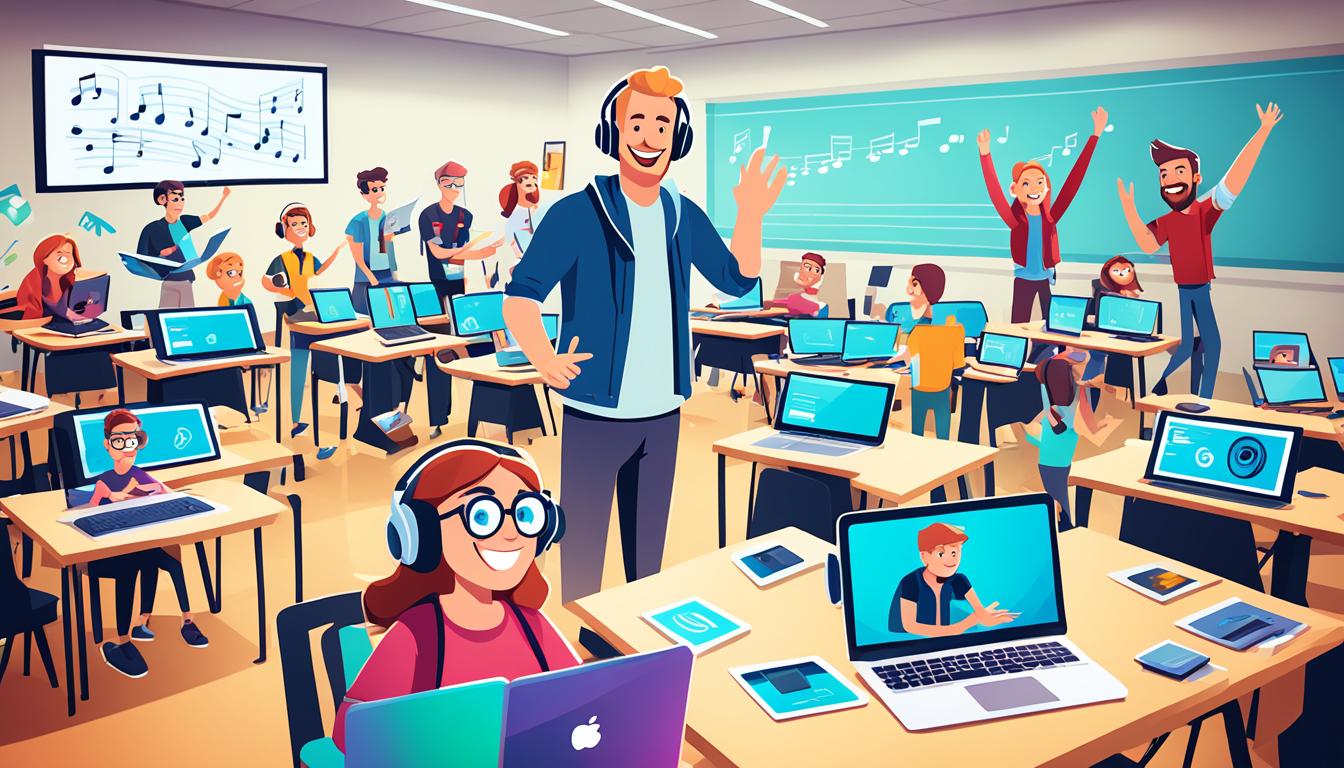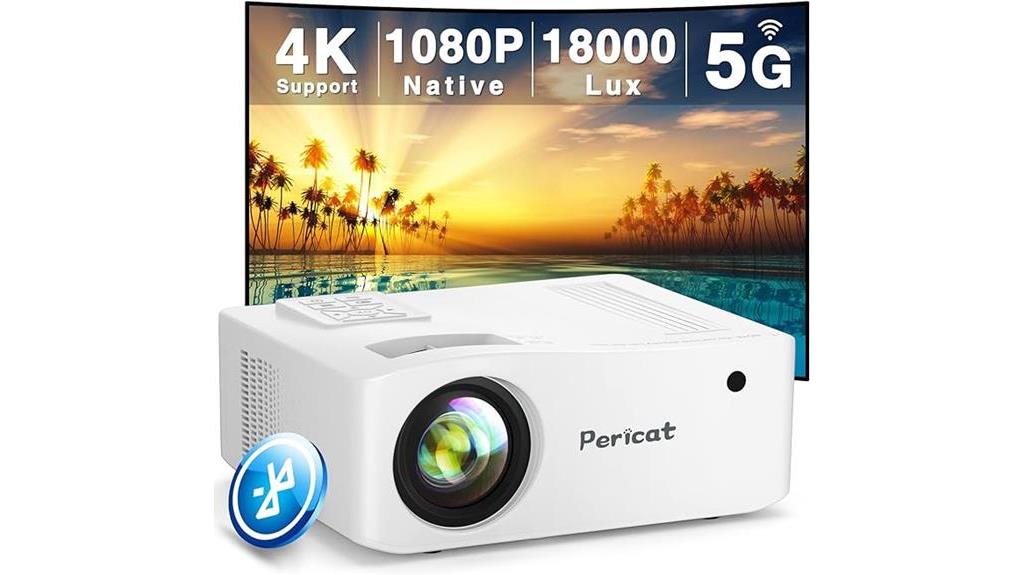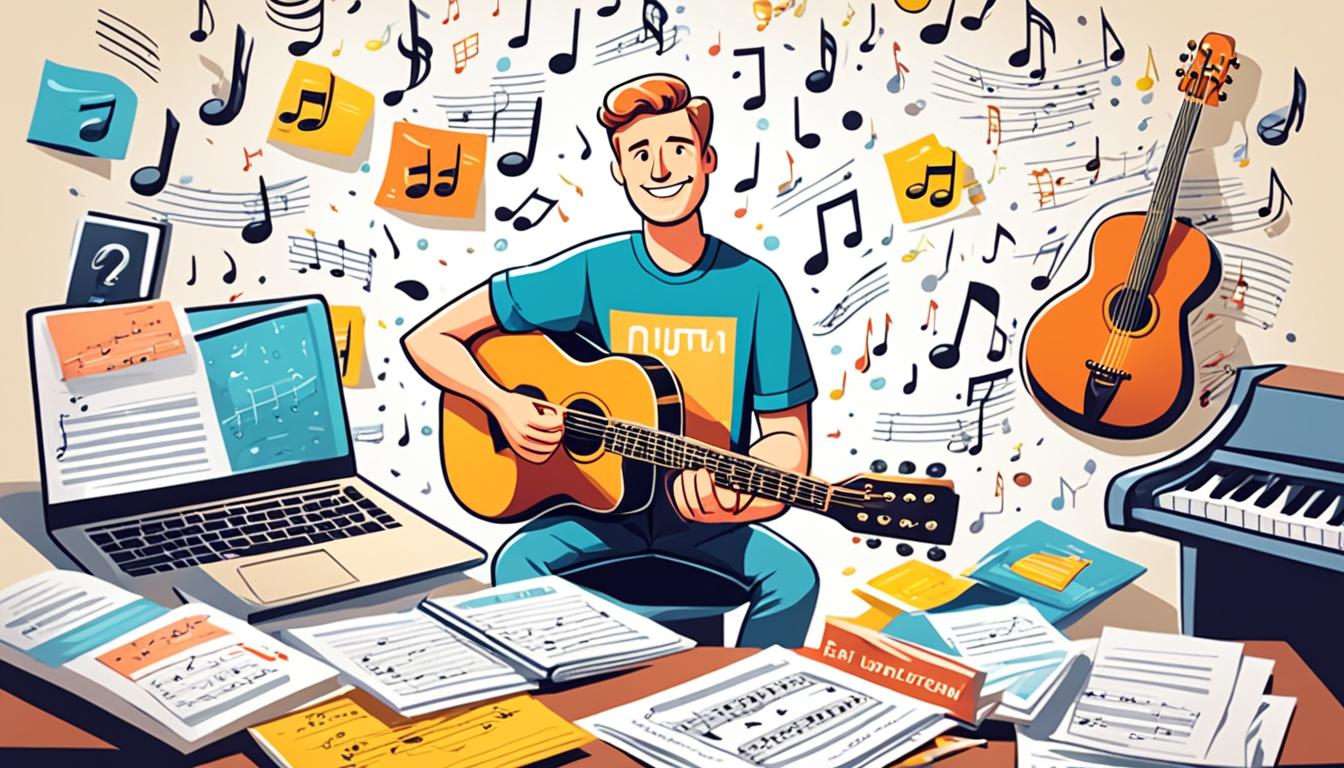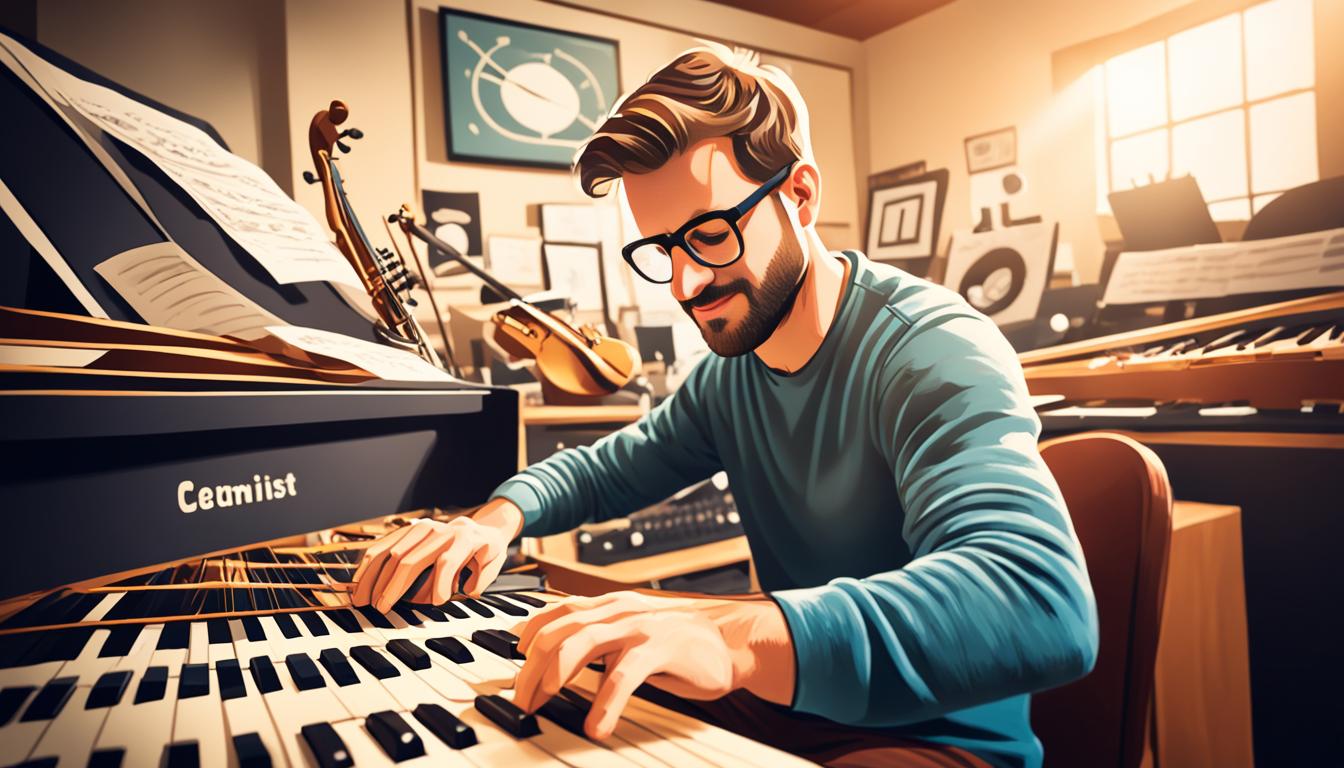Technology in the 21st century has deeply changed many parts of the music industry. It has impacted how we make and share music, perform live, and how we teach music. As a music teacher today, using modern tech in your classes is key. It makes learning better for your students.
Imagine a music class where students learn instruments and also dive into digital music making. Meet Sarah, a music teacher who saw how important tech could be for music classes. She decided to use it in her teaching.
Sarah introduced her students to music software. This let them try out various sounds, beats, and effects. They made their own music, mixing different instruments and electronic beats. The students loved the new possibilities and became even more excited about music.
But, not every music teacher is like Sarah1. Many are slow to bring tech into their classrooms. Research over 40 years shows only a bit of improvement in student learning with technology1. The reasons? Not enough computers, little technical help, and not enough training for teachers1. It’s important for teachers to get past these hurdles to make the most of tech in music education.
Key Takeaways:
- Technology has revolutionized various aspects of the music industry.
- Integrating modern tech into music classes enhances the learning experience.
- Many music educators have been slow to adopt technology in their classrooms.
- Barriers like the lack of computers and technical support hinder the widespread integration of technology in music education.
- Overcoming these barriers is crucial to fully leveraging the potential of modern tech in music education.
The Influence of Technology on Music Production
Technology has changed music production. It’s easier now for musicians to make music on their own. Digital recording lets artists make great music at home, without needing a big studio.
Tools like GarageBand and Ableton Live have changed the game. Musicians can try new sounds without spending a lot. These programs have cool effects for making music sound professional2.
Music tools are also in schools now, helping students get creative. They can make their own tunes with software like BandLab. This prepares them for the future of music2.
There are online courses for all levels of musicians. These courses teach how to use music software effectively. Learners get to practice skills and get feedback through interactive exercises2.
Music apps are making learning fun for everyone. Apps like Yousician teach how to play instruments with engaging lessons. They make music education enjoyable and effective2.
VR and AR are bringing new ways to learn music. These technologies let students explore and play in virtual worlds. They make learning music more exciting, especially for young students2.
Technology has opened doors for independent musicians. Now, anyone can create music and share it with the world. The future of music looks promising, with more tools and technologies for artists2.
Technology and Music Distribution
The internet and digital platforms have changed how we get and enjoy music. Services like Spotify and Apple Music have opened up music to the whole world3.
These platforms help new artists get noticed and reach people everywhere. Now, musicians can connect with fans far and wide. This has opened up new chances for artists to become known and successful.
Music access has grown, but how artists make money has changed too. Before, selling albums was a big deal for an artist’s income. Now, making money comes more from touring and selling merchandise3.
Artists now concentrate on great live shows and cool merch. They use online platforms to promote tours, sell tickets, and talk with fans. This creates a community and keeps fans loyal3.
Also, technology has made it easier for anyone to make music. Independent artists can now produce music at home or in small studios. This change has helped many aspiring artists3.
The use of electronic instruments has changed performances too. Musicians can try out different sounds, making shows more interesting for everyone3.
Tech has also shaped music learning. Online courses, like those from Yellowbrick, teach about music production and the business. This helps musicians learn important skills for today’s world3.
But, using technology in music has its downsides. Some schools might not get the same tech tools, which isn’t fair4.
There are privacy worries with AI in music classes, too. Even though AI gives good feedback, it could make us forget to work on our basic music skills4.
Not every student has the same chance to use AI in music. This is a problem that needs attention4.
Even with these issues, tech has positively changed music. It’s made music more accessible and given artists new ways to earn. It’s reshaping the music world, offering new possibilities and challenges for all involved.
Technology’s Impact on Live Music Performances
Technology has changed how we make and enjoy live music, making concerts more exciting and engaging.
Electronic instruments and equipment like synthesizers have opened new doors for musicians. They help create sounds and styles that were not possible before. This has made live music more creative and interesting.
It’s not just about the music. Lights and visuals add to the show, making it a feast for the eyes. These tech-wonders, like LED walls, work with the music to make concerts memorable.
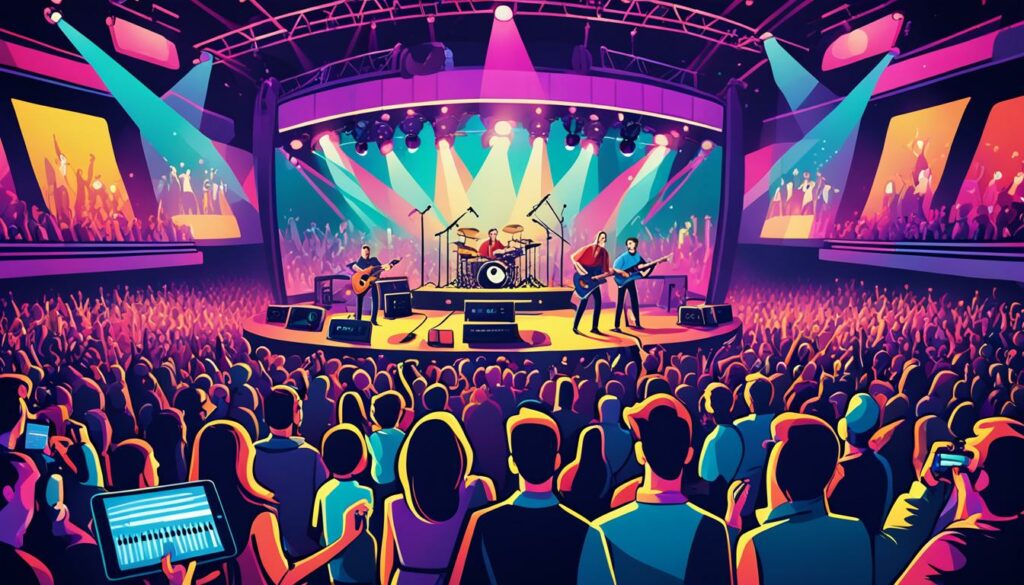
Technology also brings musicians together, no matter where they are in the world. They can share and make music together online. This has given birth to new styles and sounds.
Without a doubt, technology has reshaped live music. It has turned concerts into experiences that thrill all our senses. Musicians use tech to make every show unforgettable.
Technology’s Role in Music Education
Technology has changed music education, offering online courses for those wanting to learn music. These platforms provide lessons on everything from making music to songwriting. They even delve into the business side of music, making learning more accessible than before.
Before this change, 46% of students mainly learned from books7. Yet, only 21% really excelled with this method7. On the flip side, 9% turned to digital learning, with a whopping 76% seeing great success7. This shows how effective technology is in music education.
Online platforms can offer courses for all skill levels. For instance, Yousician has lessons for budding pianists and guitarists to learn at their pace7. Smart Pianist helps improve piano skills, giving users a virtual concert feel7.
For singing, apps like Auralbook and Swiftscales help warm up and strengthen the voice7. Artificial intelligence is even starting to provide personalized lessons, making learning more dynamic7. This approach keeps students focused and excited about music.
But technology in music learning has its downsides. It can demotivate students if there’s no teacher interaction or peer support7. Tech problems can also disrupt lessons. Yet, blending online with teacher-guided learning can greatly improve how music is taught7.
Technology is key in making music education fun and interactive. Tools like Internet MIDI and microphones are crucial for good online lessons. They help students develop musically and adapt to new learning styles7. Embracing tech helps students pursue their music passion and succeed in a changing music landscape.
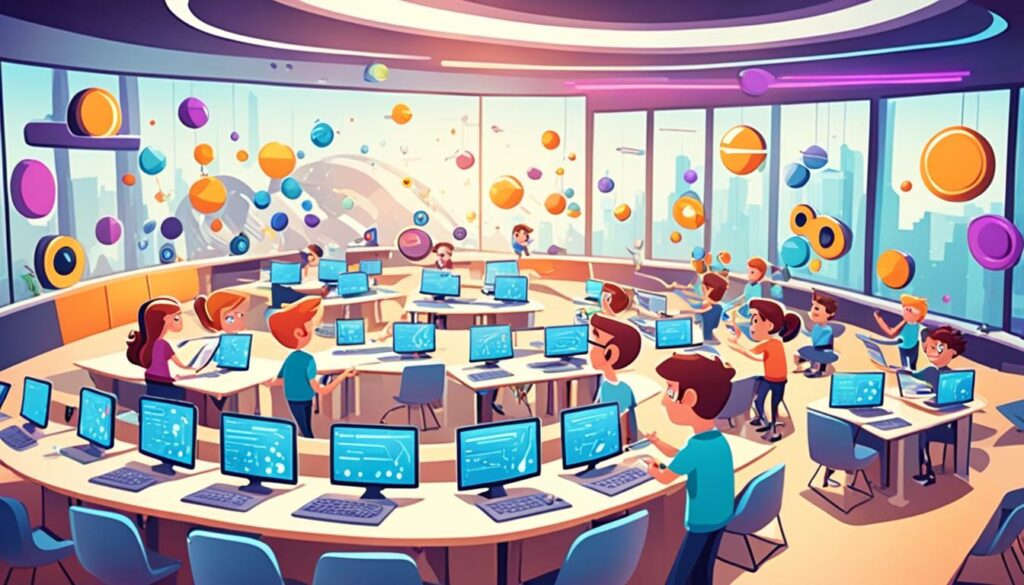
The Influence of Technology on Music Appreciation
Technology has changed how we get and enjoy music. Thanks to digital platforms and streaming services, we can now easily find all kinds of music. These services let users explore new songs and artists whenever they want.
Now, people from everywhere can discover music they’ve never heard before. No matter if you’re into classical, electronic, or folk music, there’s something for everyone. Digital platforms have opened up the world of music, making it easy for anyone to find something they like.
The ease of getting to music online has helped music streaming grow fast. One study8 shows that technology has been used in education from the early 20th century. It improves students’ learning and thinking abilities. Plus, it can change classrooms to promote critical thinking, changing how we learn music.
“With digital platforms and streaming services, listeners have a vast library of music at their fingertips, allowing them to explore a diverse range of genres and artists.”
Technology also lets us understand music better by providing tools for analysis. Streaming services give us playlists and recommendations based on what we’ve listened to. This makes finding new music that fits our taste easier and more fun.
Technology plays a big role in teaching music too. One study9 says using tech in music education is key. It opens up more ways for students to learn, making classes more active, creative, and practical. Tools and software make learning music more interactive and fun.
Teachers can use technology to teach about different music styles and cultures. Using tech, traditional folk music can be part of music lessons. This helps students appreciate the richness of musical traditions from around the world.
In the end, technology has really changed how we enjoy and understand music. It has made music from all genres more accessible, personalized our music experience, and transformed how music is taught. As technology keeps getting better, it’s exciting to think about how it will continue to enhance our music experiences89.
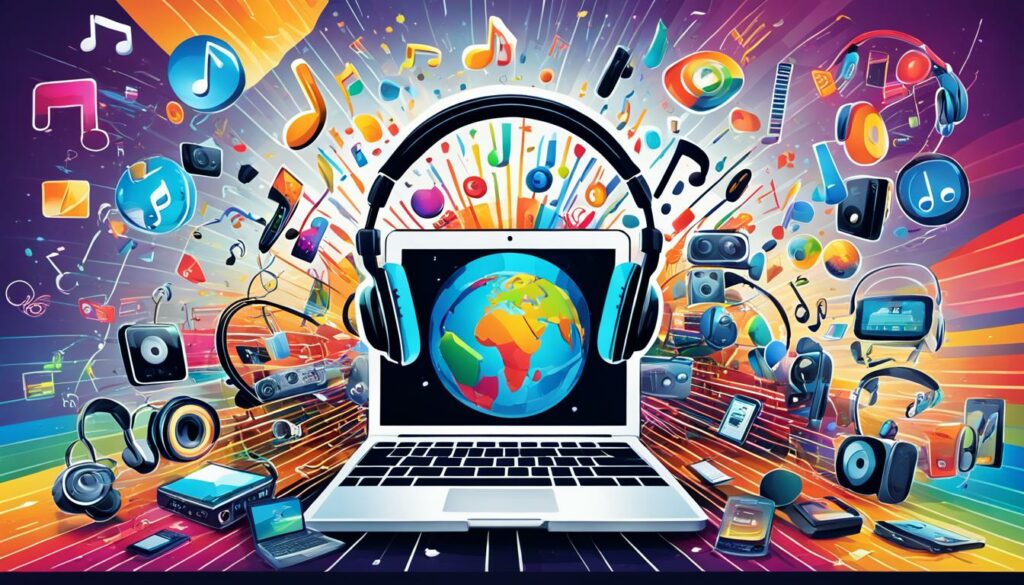
The Future of Music and Technology
Emerging tech like virtual reality (VR) and artificial intelligence (AI) is reshaping music’s future. These innovations promise to change how we make, play, and listen to music. They will introduce immersive and personalized musical experiences.
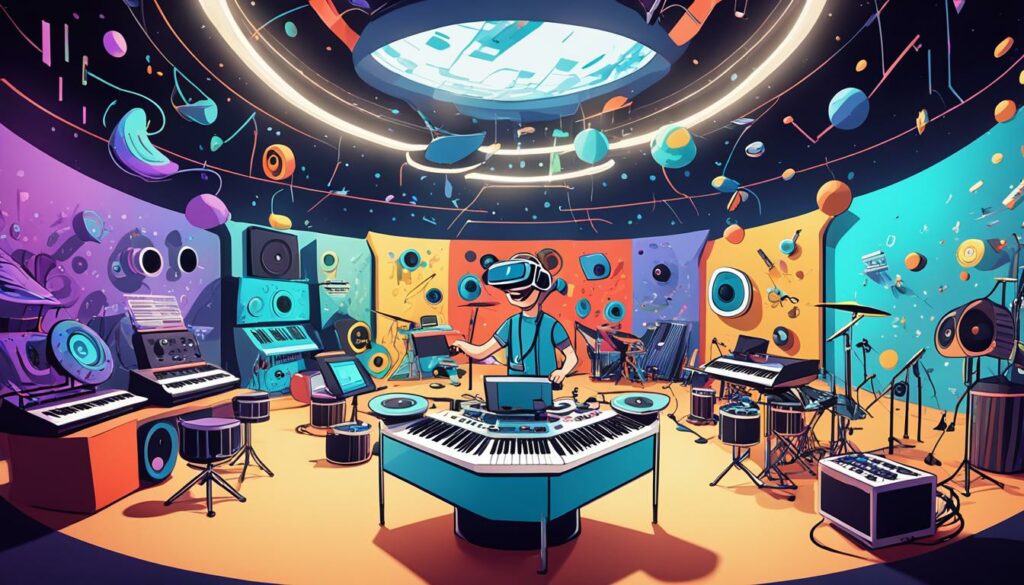
VR can take people to virtual concerts or let them start their own digital bands. It makes listeners feel like they’re really there, deepening their connection to the tunes. With VR, every concert or musical journey feels like a unique experience.
AI offers amazing opportunities for musicians and producers. It can create custom lesson plans that match a student’s skills and interests10. Such personalized learning helps students achieve their musical goals.
AI also helps in songwriting, coming up with new ideas or even collaborating with artists10. This blend of AI and creativity is driving music into new territories of innovation and experimentation.
Technology has already transformed music education, making it more accessible. Now, everyone can learn music online, at their own speed, with resources for every level and interest10. This has opened up music education to a broader audience.
Learning apps add fun to music practice through gaming elements10. These apps encourage students to practice more by making learning enjoyable.
“The future belongs to those who believe in the beauty of their dreams.” – Eleanor Roosevelt
Emerging Technologies in Music Education
| Technology | Benefits |
|---|---|
| Virtual Reality (VR) | Immersive music education experiences |
| Artificial Intelligence (AI) | Personalized lesson plans and music composition assistance |
| Online Platforms | Increased accessibility to music education |
| Music Learning Apps | Gamified elements for motivation and engagement |
The blend of music and tech is paving new paths for how we engage with music. Embracing these technologies offers endless opportunities to enhance our musical experiences. It empowers us to dive deeper into our creativity.
Overcoming Challenges and Adopting Modern Tech
Using modern technology in music classes brings many benefits and some problems. Schools need to be ready to handle these issues as they bring tech into the classroom.
Tackling new tech comes with a learning curve. Teachers have to learn how to use new tools and get the right training. This helps them add these technologies to their music lessons11.
It also means thinking hard about how to make tech work in class. Teachers must plan out how tech fits with the lessons. They have to think about matching it with the curriculum, figuring out resources, and keeping students interested11.
There’s also the challenge of using tech without losing the core of music education. It’s key to use tech for creativity and learning while sticking to the basics of music12.
One way to beat these problems is to start small with tech. Picking just an app or two that helps with the lessons is a smart move. ‘GarageBand’ helps teach composing, while ‘Rhythm Trainer’ is great for learning rhythms. Starting with a few tools makes it easier to add more later12.
Being open to try new teaching methods is vital. Teachers should test different tech to see what works best for their classes. This approach encourages learning and makes the most out of using tech in music lessons12.
Tools like ‘Chrome Music Lab’ also make class more fun and engaging. They let students dive into various music topics interactively. This adds excitement and a new way of learning to the classroom12.
Overall, blending modern tech into music lessons means having the right training, trying new things, and making detailed plans. By doing this, teachers can make music education better and more fun with technology.
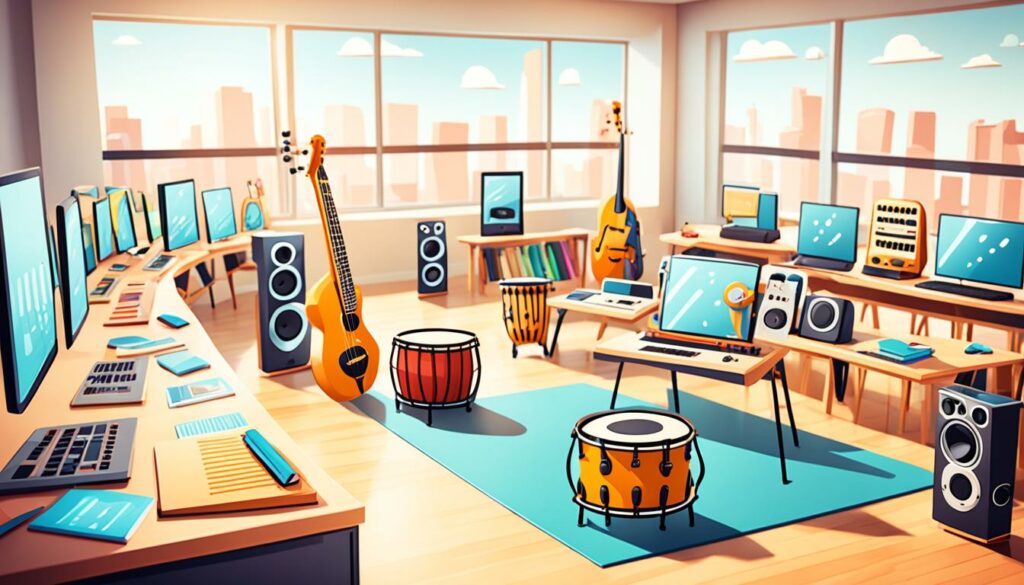
Benefits of Integrating Modern Technology in Music Education
Modern technology in music education boosts student interest and supports tailor-made learning. It also offers hands-on tools for a better musical journey.
There’s been a big move towards online learning and using tech in music13. Now, students can tap into huge music libraries from their devices. This makes learning easy and flexible.
Artificial intelligence13 has changed how we assess students’ music skills. AI helps with personalized tips and feedback. This assists in building students’ musical abilities.
Apps for ear training and understanding music theory13 make learning fun. They use games to help students improve their music knowledge and skills.
Upgrading tech in music classes improves how students learn13. Tools like interactive boards and virtual reality make music more fascinating. They help spark students’ creativity and interest in music.
Sharing music has gotten easier, too13. With platforms like Soundtrap and YouTube, students can collaborate and share their works. This helps them get feedback and grow.
Teachers can use platforms like SoundCloud14 to reach students. Music from stars on Solfeg.io14 invites students to discover various music styles.
To boost ear training, Perfect Ear – Ear Trainer app14 is great. It’s free on iOS and Android. It offers exercises to recognize tunes and chords.
For those into making music, GarageBand14 is ideal. It’s easy to use, letting students create and tweak tunes. This sparks their creativity.
SmartMusic14 is another amazing tool that comes with a subscription. It gives feedback on students’ music, helping them perfect their art.
Technology makes music education dynamic and fun. It gives students the power to polish their music talent and explore digital possibilities.
Conclusion
Modern technology has changed how we learn music15. Today, more than 90% of music teachers use digital libraries in their lessons15. Music learning apps have become 45% more popular in five years15. Also, 60% more students are signing up for online music classes worldwide15.
Tools like Yousician and Simply Piano give students interactive lessons online16. VR and AR let students step into musical worlds16. These tech tools make learning fun, more creative, and easy to get into16. They have made music education cheaper and open to more people16.
Even with tech challenges, new apps are solving problems16. Learning games increase fun and participation in class17. Online tools help students work with teachers from anywhere17. They also get to use big online music databases and make their own songs17.
Using new tech, teachers are changing how we learn, play, and share music16. Looking ahead, things like AI and blockchain could make learning even better16. This tech-match has opened new doors for musicians to share their work widely, even for free on Novecore16.
To wrap it up, tech in music education has made learning way more interactive and personal15. As tech grows, it will keep changing music education for the better. This prepares a new wave of musicians who are tech-savvy15.
FAQ
How has technology revolutionized music production?
How has technology changed music distribution?
In what ways has technology impacted live music performances?
How has technology influenced music education?
How has technology made music more accessible?
What does the future hold for the intersection of music and technology?
What challenges are associated with incorporating technology in music education?
What are the benefits of integrating technology in music education?
How has technology revolutionized music appreciation?
Source Links
- https://www.newdirectionsmsu.org/issue-1/bauer-music-learning-and-technology/ – Music Learning and Technology
- https://opus1.io/blogs/5-innovative-ways-to-use-technology-in-music-education-and-learning – 5 Innovative Ways to Use Technology in Music Education and Learning
- https://www.yellowbrick.co/blog/entertainment/the-impact-of-technology-on-music-a-deep-dive – The Impact of Technology on Music: A Deep Dive – Yellowbrick
- https://www.nfhs.org/articles/artificial-intelligence-ai-integration-in-high-school-music/ – Artificial Intelligence (AI) Integration in High School Music
- https://www.music.org/cms-reports/celebrating-the-40th-anniversary-of-the-museum-of-modern-art-tape-music-concert/the-impact-of-technology-on-the-musical-experience.html – The Impact of Technology on the Musical Experience
- https://aaft.com/blog/music/the-impact-of-technology-on-the-music-industry/ – The Impact of Technology on the Music Industry
- https://www.ncbi.nlm.nih.gov/pmc/articles/PMC10102675/ – The role of a teacher in modern music education: can a student learn music with the help of modernized online educational technologies without teachers?
- https://www.adayapress.com/wp-content/uploads/2019/07/RTB1.pdf – PDF
- https://www.matec-conferences.org/articles/matecconf/pdf/2022/12/matecconf_isc-be2022_01054.pdf – Research on the teaching innovation model of the integration of information technology and music education
- https://medium.com/@sweetskolkatta7/the-future-of-music-education-trends-and-innovations-to-watch-aebcff9e49e1 – The Future of Music Education: Trends and Innovations to Watch
- https://www.unescoejournal.com/wp-content/uploads/2020/03/2-2-12-GOUZOUASIS.pdf – PDF
- https://www.linkedin.com/pulse/4-tips-how-integrate-music-tech-your-classroom-damir-odobasic – 4 Tips on How to Integrate Music-Tech in Your Classroom
- https://sbomagazine.com/music-education-in-the-digital-age-harnessing-technology-for-student-engagement/ – Music Education in the Digital Age: Harnessing Technology for Student Engagement
- https://solfeg.io/music-education-technology – 6 Examples of Using Technology in The Music Classroom – Solfeg.io
- https://www.obscuresound.com/2024/01/9-ways-technology-is-revolutionizing-music-education/ – 9 Ways Technology is Revolutionizing Music Education
- https://blog.novecore.com/revolutionizing-music-education-with-technology/ – Revolutionizing Music Education with Technology – Novecore Blog
- https://news.theurbanmusicscene.com/2023/10/integrating-tech-in-music-education-boosting-engagement-study/ – Integrating Tech in Music Education: Boosting Engagement & Study

